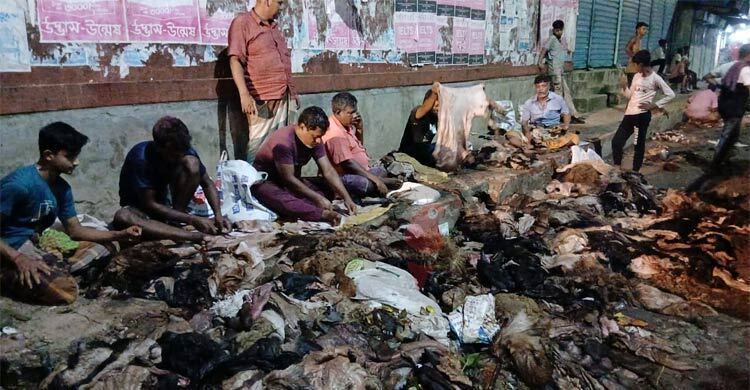
In Aminbazar, a key trading hub for sacrificial animal skins in Dhaka and surrounding areas, the market for goat and sheep skins has collapsed this Eid-ul-Azha season. While large cow hides are fetching Tk 850 to Tk 900 each, goat and sheep skins have no buyers, forcing seasonal traders to discard them on roads and sidewalks, exacerbating financial losses and waste management challenges.As of noon on Sunday, June 8, 2025, no shopkeepers in Aminbazar were observed purchasing goat or sheep skins.
The lack of demand stems from tanneries offering prices for these smaller hides that are lower than the cost of salt needed for preservation, rendering them commercially unviable.
Cow hide trading, while active, is also down, with lower supply compared to previous years.
Shahidul Haque, a local shopkeeper, told Jago News, “The supply of skins is much lower today. I’ve bought only 20 cow hides since morning, compared to over 600 on Eid day yesterday. Prices for cow hides remain Tk 850 to 900, but no one is buying goat skins because tanneries offer unprofitable rates.”
Maqsud Alam, a trader who brought six goat skins to Aminbazar, expressed frustration: “I don’t know what to do. Goat skins have no value, and no one is taking them. I came all this way for nothing.”
Unable to sell, many traders have abandoned their goat skins, creating piles of discarded hides along the sidewalks of Dhaka-Aricha Highway.
The collapse in demand for goat skins reflects deeper issues in Bangladesh’s leather industry. While cow hides drive export earnings—targeting over $1 billion annually, per the Ministry of Commerce—goat and sheep skins are increasingly overlooked.
Md Shahadat Ullah, Senior Vice Chairman of the Bangladesh Tanners Association, explained to Jago News, “When tanneries were relocated from Hazaribagh to Savar in 2017, those processing goat skins couldn’t make the shift. The tanneries in Savar lack the capacity to process goat skins, and many are operating at a loss or have nearly closed. Goat skins are small, often have cuts, and incur high maintenance costs, making them unprofitable.”
Despite the Ministry of Commerce’s announcement of a price hike for raw hides before Eid-ul-Azha—setting salted goat skins at Tk 22 to Tk 27 per square foot (up from Tk 20 to Tk 25) and unsalted goat skins at Tk 20 to Tk 22 (up from Tk 18 to Tk 20)—the measure has failed to stimulate the market. Syndicate manipulation continues to undermine government-set prices, particularly in Chittagong, where traders reported selling hides below the fixed rates.
In Chattogram’s Aturar Depot, an on-site inspection revealed that many seasonal traders waited until late at night but could not sell their goat skins, even those suitable for preservation.
By Saturday evening, hundreds of goat skins were discarded in dustbins.
Some individuals, like Babul Das, a skin collector, were seen salvaging these hides to remove excess meat for preservation.
Babul Jago News, “During Qurbani Eid, shops focus on large animal hides. Goat skins, which are bought at other times for drum-making, are ignored now. We collect discarded skins, but the volume during Eid isn’t enough for drum production, and dried skins usually cost Tk 100 per piece.”
The discarded skins are straining Dhaka’s waste management system, with the Dhaka North City Corporation reporting that approximately 20,000 tonnes of sacrificial waste, including hides, are being transported to the Aminbazar landfill.
For traders, the inability to sell goat skins represents not only financial loss but also a missed opportunity for Bangladesh’s leather industry, which urgently needs better regulation and investment to revive the market for smaller hides.

